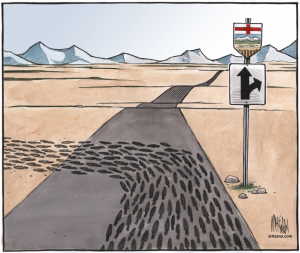In 2011 the Union of B.C. Municipalities voted in its annual convention to ask the B.C. provincial government to put a “moratorium” on its plan to revamp the province’s power grid. The core of this plan involved the installation of smart meters.
In B.C. and many other jurisdictions in the world there is growing resistance to installing smart meters. Smart meters are a high-tech wireless device designed for two-way broadcasting through the medium of high-frequency microwave radiation.
At the B.C. municipal union “some of the concerns brought up by the delegates included health impacts, privacy issues, and potential rate hikes.” Sharon Noble, spokesperson for the Coalition to Stop Smart Meters, warned that if the B.C. Energy Ministry “chose to ignore what people have said through their councillors, through their mayors, then I think the government is making a big mistake.” She anticipated “plans to take the government to court over human rights complaints.”
In Lethbridge, our city government is not in a position to respond like municipal governments did in B.C. to growing public concerns. Because of the differences in our provincial histories, our city government is the primary custodian and renovator of our local power grid and metering system.
Unbeknownst to most Lethbridge residents, the city is rapidly pushing ahead with the installation of wifi communication devices that it refuses to identify as smart meters. At a recent community meeting at the University of Lethbridge, Mayor Chris Spearman commented that 19,000 meters have been installed with 26,000 yet to go.
At this gathering organized by the U of L’s New Media instructor, Lance Chong, there was a specific focus on a City of Lethbridge web page entitled “Electric Meter Replacement — Frequently Asked Questions.” One of the statements was that “the meters being installed in the city are not smart meters.” It also stated “the meters are safe.”
At this public meeting, our mayor repeatedly emphasized the safety of the electric meters. As on his own Facebook page, Mayor Spearman justified his claim by directing people to Health Canada’s Smart Meters information packages. He specifically pointed out that “Health Canada has issued limits of human exposure to RF (radio frequency) radiation in Safety Code 6.”
While city officials insist that the installed devices are not smart meters, they concurrently direct citizens’ public safety concerns to Health Canada’s assessment of “smart meters.”
The deceptiveness of this communications strategy raises important issues about consent. Indeed, the only document announcing the changeover in technologies calls into question the city government’s understanding of our collective and individual right to give informed consent to this controversial technology.
An official letter from the City of Lethbridge placed into the mailbox of every “resident/homeowner” states that “Electric Operations is replacing residential electric meters in the city, and your meter will be replaced within the next four-week period.”
The recipients are told they can call a city line during business hours if they have any questions. The letter also indicates, “As the meters are on the exterior of most homes, we will complete the work if no one is at home… The replacement process will take approximately five minutes.” The experience of litigation in other jurisdictions suggests that the City of Lethbridge is acting as if the failure to phone the assigned number for whatever reason constitutes “implied consent.”
The debate in B.C. demonstrates the breadth of concerns about the changeover to smart meters, or “Smart Grids” as an Alberta government report referred to the new technology in 2011. Done at the behest of the Alberta government, the publication is entitled Alberta Smart Grid Inquiry: Final Report.
The authors of the “final report” explain that “Smart Grid” is a “broad concept that describes the integration of hardware, software, computer monitoring, control technologies and modern communications strategies in the electricity grid.” The report underlines that smart meters are a part of Alberta’s Smart Grid plan. It refers to the City of Lethbridge’s relationship to the project along with that of Atco, Enmax, Epcor, Direct Energy and Fortis.
A special section is devoted to privacy issues. This topic is clearly connected to warnings that smart meters provide public utilities along with their attending corporations and governments with vast new surveillance capabilities and potentials. The Smart Grid Report notes that the then-privacy commissioner of Alberta, Frank Work, QC, cautioned that many privacy issues remain unaddressed.
Specifically, Work pointed out that the engineering of the Smart Grid could not advance until Alberta’s privacy laws were taken into account. These statutes include the Alberta’s Personal Information Act, the Freedom of Information and Privacy Act, and the Health Information Act.
These observations indicate that the City of Lethbridge is withholding important information from its constituents that we need to make informed, democratically-based decisions about our new Smart Meter and Smart Grid technology. The city’s haste of installation together with its eclipsing of the true nature of smart meters indicates that serious investigation is required. Could this haste have anything to do with the recent change in the provincial government from PC to NDP control?
The smart meter project is more consequential than a simple “replacement” of electric meters. It’s part of a far-reaching international reengineering of our power infrastructure. Smart meters, smart grids, and ubiquitous two-way microwave communications are impacting our lives in many ways.
Mayor Spearman owes his constituents open-minded consideration of our concerns as well as full disclosure about the true nature of the project. It would be a conflict of interest for him to act exclusively as a proponent of smart meters. An immediate halt to the project would enable the community and individuals to become collectively informed about our options. We do have a choice.
Anthony Hall is a professor of Globalization Studies in the Liberal Education Program at the University of Lethbridge.
![]()
